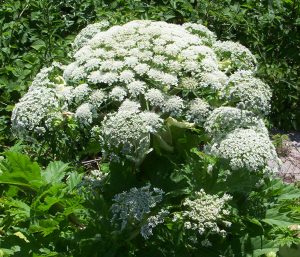 An invasive plant that can cause third-degree burns and blindness has been found in Virginia. The Virginia Department of Transportation reported sightings of the Giant Hogweed in Middlesex County and in Frederick County. More of the plants have also been found in Clarke County. A warning about the huge weed was posted on Facebook by officials in Isle of Wight County.
An invasive plant that can cause third-degree burns and blindness has been found in Virginia. The Virginia Department of Transportation reported sightings of the Giant Hogweed in Middlesex County and in Frederick County. More of the plants have also been found in Clarke County. A warning about the huge weed was posted on Facebook by officials in Isle of Wight County.
The weed, which originated in Asia, can grow anywhere between 8 to 14 feet tall when it’s flowering. The leaves can be up to five feet across. When blooming, the plant has numerous white flowers that cluster into a flat-topped “umbrella.” The spray of white flowers looks similar to Queen Anne’s Lace, but the Giant Hogweed is much larger.
Severe complications can occur from contact with a Giant Hogweed plant. The plant’s hollow, rigid stem houses a toxic sap containing chemicals known as photosensitizing furanocoumarins. When these chemicals come into contact with human skin, it can cause phytophotodermatitis, a condition that makes the skin so sensitive to sunlight that severe burns can occur from normal exposure to the sun. The condition can last many years.
This is the first time that the Giant Hogweed plant has been spotted in Virginia. It is believed that the plant spread to the new locations via seeds dropped by birds. The seeds of the plant can grow for 10 years once they’ve been dropped off.
The plant may also be growing in other states. In previous years, warnings have been issued after discoveries in the Northeast, Midwest and Pacific Northwest. The plant was listed as an emerging threat in 2017 by the Tennessee Invasive Plant Council. Sightings of the plant have also been confirmed in Michigan and New York.
